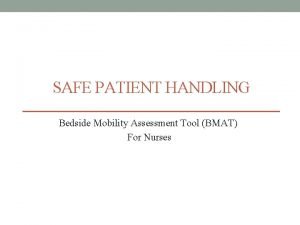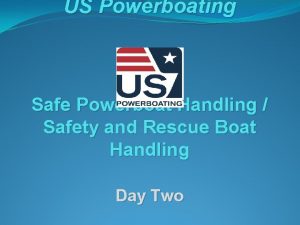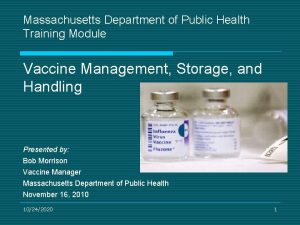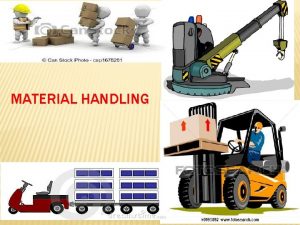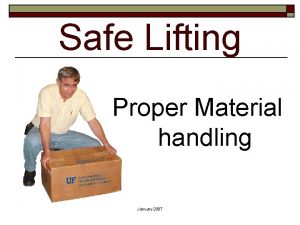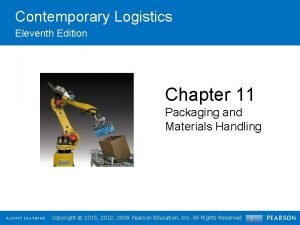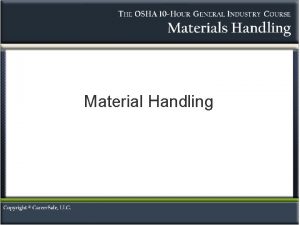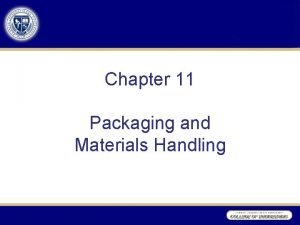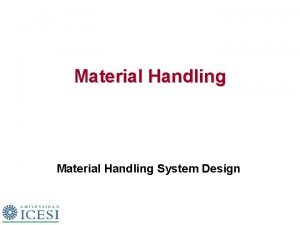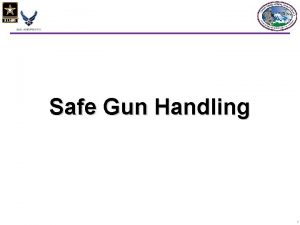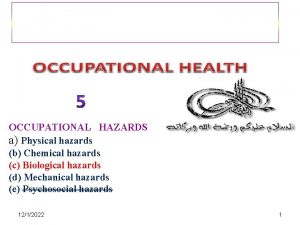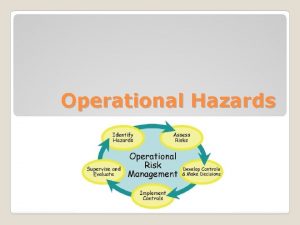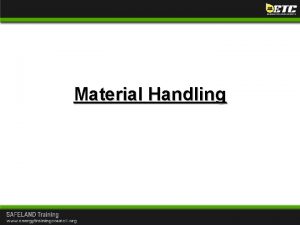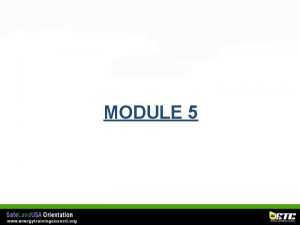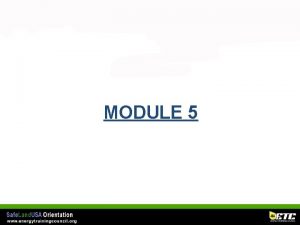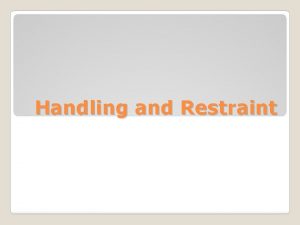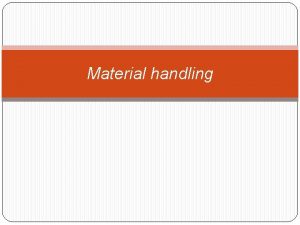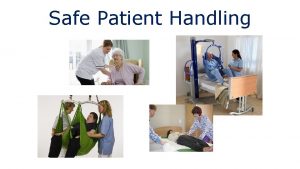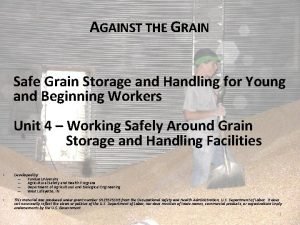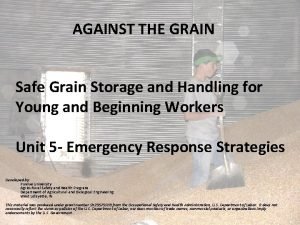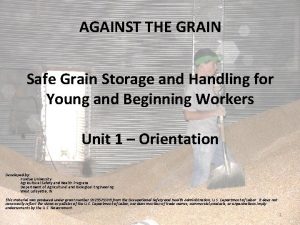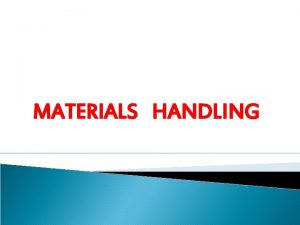Safe Handling Storage of Materials March 2018 Hazards





























- Slides: 29

Safe Handling & Storage of Materials March 2018

Hazards of Manual Material Handling Be Aware: Injury can occur from manual material handling tasks, however following safe work practices can prevent these types of injuries. For example: • Soft tissue sprains, strains and tears • Bruises and contusions • Cuts and punctures • crushing injuries or amputations

Part 1 MANUAL MATERIALS HANDLING

Planning Before moving materials: • Plan the lift and the route – Identify possible hazards, limitations, route safety, and final placement • Evaluate the weight and shape of the load • Consider: – – Is Personal Protective Equipment needed? Should the load be broken up into multiple moves? Is assistance required from a mechanical device or coworker? Will other workers or students be affected?

The Load • Reduce the weight of the load by decreasing the: – size of the object (e. g. buy smaller sizes) – weight of the container (e. g. plastic is lighter than steel) – capacity of containers – load in the container – Breaking it down to multiple, smaller loads

The Load Cont… • Decrease the load on the employee by: – limiting the number of objects that are handled during the day – rotating tasks – Designating heavier or awkward loads as team lifts (ie. 2 or more persons) – Changing size and shape of load so employee can get closer the load’s centre of gravity

Pushing and Pulling • Make loads easier to push/pull by using: – Carts, hand trucks and dollies with large diameter casters and good bearings – Grips/handles on loads or mechanical aids, placed to provide optimal push force and prevent awkward postures

Use of Hand Trucks • Includes: wheelbarrows, dolly trucks and 2 -wheeled hand trucks) • 2 -wheeled hand trucks should be equipped with brakes • Heavy objects should be loaded before lighter ones • Keep the load as low as possible as not to obstruct your view • Use proper lifting techniques • Push & balance truck while always walking forward • Don’t hold the truck in place with your foot

Key Points • Push rather than pull • Avoid overloading – limit the load pushed or pulled at one time • Do not exceed mechanical equipment load capacities • Ensure the load does not block vision • Never push one load and pull another at the same time

Part 2 CARRYING AND HOLDING

Reduce the Force • Make the material movement a pushing or pulling task • Use mechanical devices (carts, dolly) • Use portable containers in which to place awkward loads • Use grips or handles on loads • Limit the distance the load is moved over

Lifting To decrease your risk of a back injury, you should avoid: ● Twisting with a load ● Hurrying ● Carrying to much at once ● Lifting with your back instead of bending at the knee

Proper Lifting

Proper Lifting Cont. . .

Part 3 ENVIRONMENTAL FACTORS

Optimal Environment • In a hot environment - take breaks as necessary away from the heat • In a loud environment - ensure lifting instructions can be heard by all team members Ensure that: • Lighting levels are adequate • Layout of the work area provides better access to the load • Aisles are free of obstacles

Part 4 GENERAL PRECAUTIONS

General Precautions • Test the weight of the load so it can be lifted securely … if not, make adjustments • Grip load securely • Protect hands from pinch points • Get help with awkward or heavy loads • Practice good team lifting • Always use mechanical devices and aids provided and be sure they are in good condition • Don’t rush or cut corners

Part 5 Storing Materials

Storage Injury or damage could result if materials are not stored properly. • Do not obstruct – aisles, stairs or exits – Fire extinguishers, eyewash stations, emergency showers or first aid kits • Keep materials clear of – sprinkler heads, smoke sensors, electrical panels and heat sources

Shelving • Shelving units taller than 4 ft should be secured to the wall • Materials stored on shelves should be secure to prevent from sliding, rolling, falling or collapsing • Store heavy items on lower shelves up to waist height • Do not overload a shelf - watch for bowing

Stacking • Stack loads straight and evenly • Correct unbalanced loads when you see it • Consider placement: – Is there enough space? – Stacking materials near operating machinery make the load subject to vibration and loss of stability

Stacking Styles Depending on the space available and the item to be stored, there are different ways to stack materials: 1) Column: Single articles placed one above the other 2) Square: Any stack with vertical sides

Stacking Styles Cont. . . 3) Lean-to: “stepped” on one side, and vertical on three sides. The stack does not actually lean against a support. 4) Bagged Goods: Place the first row with the bags laying flat, and continue interlocking with the following tiers.

Stacking Styles Cont. . . 5) Cylindrical items: If stacked on their sides, wedges (or chocks) should be fixed to the sides to prevent rolling. 6) Gas cylinders: use restraining chains to secure upright cylinders.

Stacking Styles Cont. . . 7) Sheet Materials: - Consider if the material can be laid flat - If stacking up on end, you must support the load to prevent tipping. Large amounts of sheet material should NOT be stored this way together. - Protect sharp edges to prevent injury to others in the area 8) Long/tall items (i. e. boards/poles): - Should be stored flat along the ground unless it can be secured upright to prevent tipping (ex. Use of chain or strap)

Special Note: Mezzanines Not all mezzanines are designed to hold storage as there may be a risk of falling or collapse. If storage is allowed on mezzanines, keep stacked materials below the half-wall height to ensure it does not fall over into the work space below.

Part 6 Conclusion

Be sure to talk to your Supervisor if you find a hazard to report or you are unsure of a task. Completing the task while preventing injury is the goal, however it is important to report any workplace injury to your Supervisor for investigation and proper documentation. Thank you
 Safety
Safety Poland national anthem lyrics
Poland national anthem lyrics Control hazards in computer architecture
Control hazards in computer architecture Handling data hazards
Handling data hazards Azure bug bounty
Azure bug bounty Safe patient handling
Safe patient handling Savage safe handling auburn me
Savage safe handling auburn me Bmat level 2
Bmat level 2 Handling patients
Handling patients 4 golden rules of gun safety
4 golden rules of gun safety Safe handling of pesticides
Safe handling of pesticides Us powerboating
Us powerboating Safe feed safe food
Safe feed safe food Safe people safe places
Safe people safe places Vaccine storage and handling sop worksheet
Vaccine storage and handling sop worksheet Light fog artifact
Light fog artifact Vaccine storage and handling protocol
Vaccine storage and handling protocol Que letra continua m v t m j
Que letra continua m v t m j Introduction of material handling
Introduction of material handling Proper handling of materials
Proper handling of materials Protective packaging and materials handling
Protective packaging and materials handling Precautions when moving materials manually
Precautions when moving materials manually Let there be light lamp shade company
Let there be light lamp shade company What is unit load
What is unit load Care and handling of library materials
Care and handling of library materials Unsafe food temperature range
Unsafe food temperature range 5 principles of safe food storage
5 principles of safe food storage Unified storage vs traditional storage
Unified storage vs traditional storage Secondary storage vs primary storage
Secondary storage vs primary storage Storage devices of computer
Storage devices of computer







